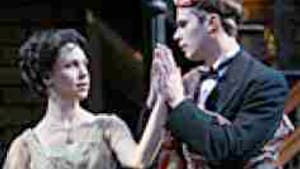Stay in the Loop
BSR publishes on a weekly schedule, with an email newsletter every Wednesday and Thursday morning. There’s no paywall, and subscribing is always free.
Romeo at the grass roots
"Romeo and Juliet' at Annenberg

In the opening scene of the Guthrie Theater-Acting Company production of Romeo and Juliet, all the characters wear rain-gear and carry umbrellas. They look heavenward, apprehensively, sensing that a storm is coming. That is accurate, figuratively. And this stage business resonates in the play's final speech, when the Prince of Verona remarks that the weather (and the mood) is gloomy and the sun won't show its head.
Another unusual element is the costuming. The style is Edwardian, with everyone dressed as if it's England in 1905. I see less rationale for this device than I do for the umbrellas. The co-producers of this touring show have targeted communities across America and, in particular, young audiences. But their choice of costumes distances us from the Veronese locale and from Shakespeare's Elizabethan society, without any discernable appeal to new viewers.
The set was simple, the accents American and the style broad. Too broad. Several characters telegraphed their speeches with unnecessary gestures.
Suitably adolescent
The men in the cast were far more effective than the women. Sonny Valicente made an appealing Romeo, looking almost like a teenager and acting suitably adolescent. Raymond L. Chapman was an unusually vigorous Friar Laurence, Chris Thorn an understandable Lord Capulet, and Jamie Smithson was a more sympathetic Paris than we normally see.
William Sturdivant, however, mugged as Mercutio. This character is a weaver of poetic imagery, but Sturdivant played Romeo's friend as a wisecracking jester. All of Romeo's pals acted like fools. It's one thing to be youthful, quite another to be clownish.
Perhaps director Penny Metropulos wanted to create a contrast between their chummy scenes in the first act and the tragic action that followed. What was lost was the sense of hostility and danger that's crucial in this play about the potential for tragedy when people are angry.
Laura Esposito, as Juliet, swung her arms and spun around girlishly but appeared much too mature of face and of figure for the 13-year-old heroine. Elizabeth Stahlmann was a fibbedy-jibberty nurse, lacking the steadiness that we expect from Juliet's caretaker, and Christine Weber was a weak Lady Capulet.
Fairy-tale romance
Alaina Mabaso recently criticized Romeo and Juliet, chiding the silliness of children wanting to marry when they've known each other for only a few days. But I think of this play essentially as a romance— almost a fairy tale— and consequently I make allowances for its absences of logic.
Consider the fact that mature adults— the Capulet parents— also want to rush their child into marriage. It makes no sense. There's no financial necessity for a quick marriage— as there is, say, in Sir Walter Scott's The Bride of Lammermoor. Likewise, it would be counterproductive to wonder how Friar Laurence could be so sure of exactly how his sleeping potion would work, down to the exact hour on which Juliet would awake.
Romeo and Juliet is a fine story despite these flaws. I'm reminded a bit of Rodgers and Hammerstein's South Pacific, which also celebrated sudden, unexpected romance. At a tribute to the composers a few years ago, the singer and actress Andrea Marcovicci shocked the audience by saying that the notion of "Some Enchanted Evening" was so unrealistic that it screwed up her personal romantic life for many years. But, like Romeo and Juliet, it touched the souls of audiences. As Hammerstein put it in that very song: "Who can explain it? Who can tell you why?/ Fools give you reasons, wise men never try."
Another unusual element is the costuming. The style is Edwardian, with everyone dressed as if it's England in 1905. I see less rationale for this device than I do for the umbrellas. The co-producers of this touring show have targeted communities across America and, in particular, young audiences. But their choice of costumes distances us from the Veronese locale and from Shakespeare's Elizabethan society, without any discernable appeal to new viewers.
The set was simple, the accents American and the style broad. Too broad. Several characters telegraphed their speeches with unnecessary gestures.
Suitably adolescent
The men in the cast were far more effective than the women. Sonny Valicente made an appealing Romeo, looking almost like a teenager and acting suitably adolescent. Raymond L. Chapman was an unusually vigorous Friar Laurence, Chris Thorn an understandable Lord Capulet, and Jamie Smithson was a more sympathetic Paris than we normally see.
William Sturdivant, however, mugged as Mercutio. This character is a weaver of poetic imagery, but Sturdivant played Romeo's friend as a wisecracking jester. All of Romeo's pals acted like fools. It's one thing to be youthful, quite another to be clownish.
Perhaps director Penny Metropulos wanted to create a contrast between their chummy scenes in the first act and the tragic action that followed. What was lost was the sense of hostility and danger that's crucial in this play about the potential for tragedy when people are angry.
Laura Esposito, as Juliet, swung her arms and spun around girlishly but appeared much too mature of face and of figure for the 13-year-old heroine. Elizabeth Stahlmann was a fibbedy-jibberty nurse, lacking the steadiness that we expect from Juliet's caretaker, and Christine Weber was a weak Lady Capulet.
Fairy-tale romance
Alaina Mabaso recently criticized Romeo and Juliet, chiding the silliness of children wanting to marry when they've known each other for only a few days. But I think of this play essentially as a romance— almost a fairy tale— and consequently I make allowances for its absences of logic.
Consider the fact that mature adults— the Capulet parents— also want to rush their child into marriage. It makes no sense. There's no financial necessity for a quick marriage— as there is, say, in Sir Walter Scott's The Bride of Lammermoor. Likewise, it would be counterproductive to wonder how Friar Laurence could be so sure of exactly how his sleeping potion would work, down to the exact hour on which Juliet would awake.
Romeo and Juliet is a fine story despite these flaws. I'm reminded a bit of Rodgers and Hammerstein's South Pacific, which also celebrated sudden, unexpected romance. At a tribute to the composers a few years ago, the singer and actress Andrea Marcovicci shocked the audience by saying that the notion of "Some Enchanted Evening" was so unrealistic that it screwed up her personal romantic life for many years. But, like Romeo and Juliet, it touched the souls of audiences. As Hammerstein put it in that very song: "Who can explain it? Who can tell you why?/ Fools give you reasons, wise men never try."
What, When, Where
Shakespeare’s Romeo and Juliet. Directed by Penny Metropulos. Co-production by The Acting Company (New York) and The Guthrie Theater (Minneapolis), April 20-24, 2010 at Annenberg Center, 3680 Walnut St. (215) 898-3900 or www.pennpresents.org.
Sign up for our newsletter
All of the week's new articles, all in one place. Sign up for the free weekly BSR newsletters, and don't miss a conversation.
 Steve Cohen
Steve Cohen